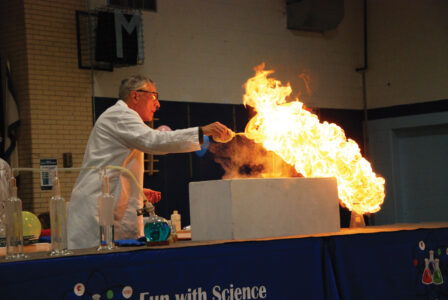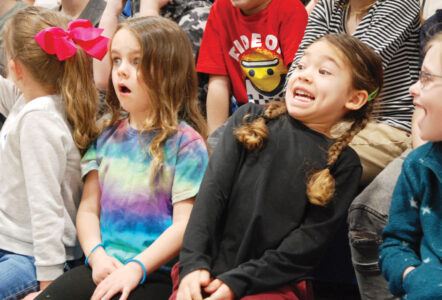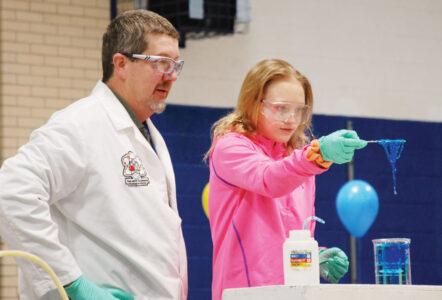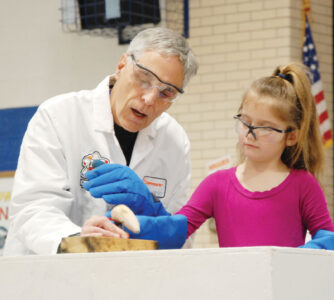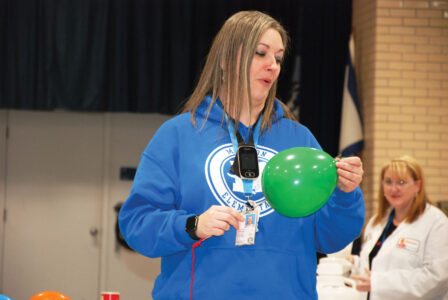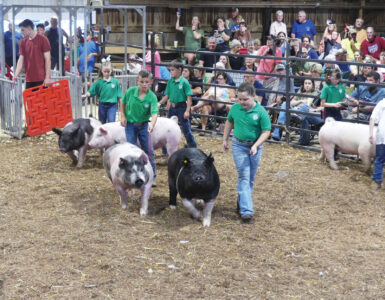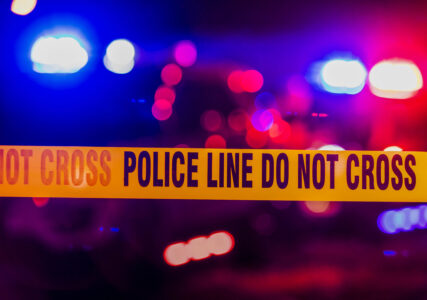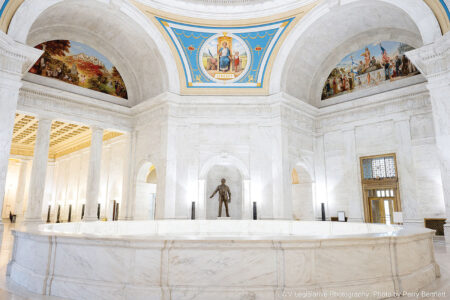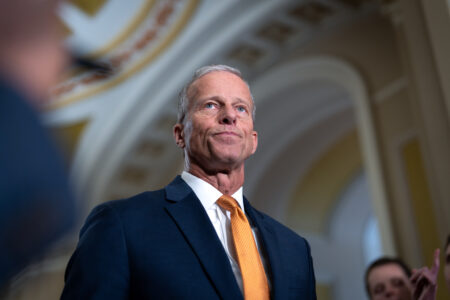Hypothesis: Science is Fun – Washington Works team educates, entertains at Madison Elementary School
- Chemours senior chemist Leo Lech used lycopodium powder to create a combustion reaction during a Washington Works Fun with Science presentation Friday at Madison Elementary School in Parkersburg. (Photo by Evan Bevins)
- Madison Elementary School kindergarteners Zaelynn Daugherty, left, and Hazel Ellis reacted to flames generated in a combustion reaction during a Washington Works Fun with Science presentation Friday in their school’s gym. (Photo by Evan Bevins)
- Madison Elementary School fourth-grader Lillyanne Winston, right, held up polymerized sodium algenate, a naturally occurring chemical found in seaweed, after pouring it in liquid form into a beaker containing a calcium chloride salt solution, under the direction of Brad Bishop, associate investigator at Chemours, during a Washington Works Fun with Science presentation Friday at the school. (Photo by Evan Bevins)
- Madison Elementary School kindergartener Lilliana Jones hammered a nail using a banana frozen in liquid nitrogen, which made for a more effective tool than the unfrozen banana she tried for the first time at the instruction of Leo Lech, senior chemist at Chemours, during a Washington Works Fun with Science presentation Friday at the school. (Photo by Evan Bevins)
- Madison Elementary School kindergarten teacher Marcia Buckley carefully pushed a needle through a balloon at the material’s darkest points, where Chemours representatives explained polymers were closer together, preventing the balloon from popping, during a Washington Works Fun with Science presentation Friday at the school. (Photo by Evan Bevins)
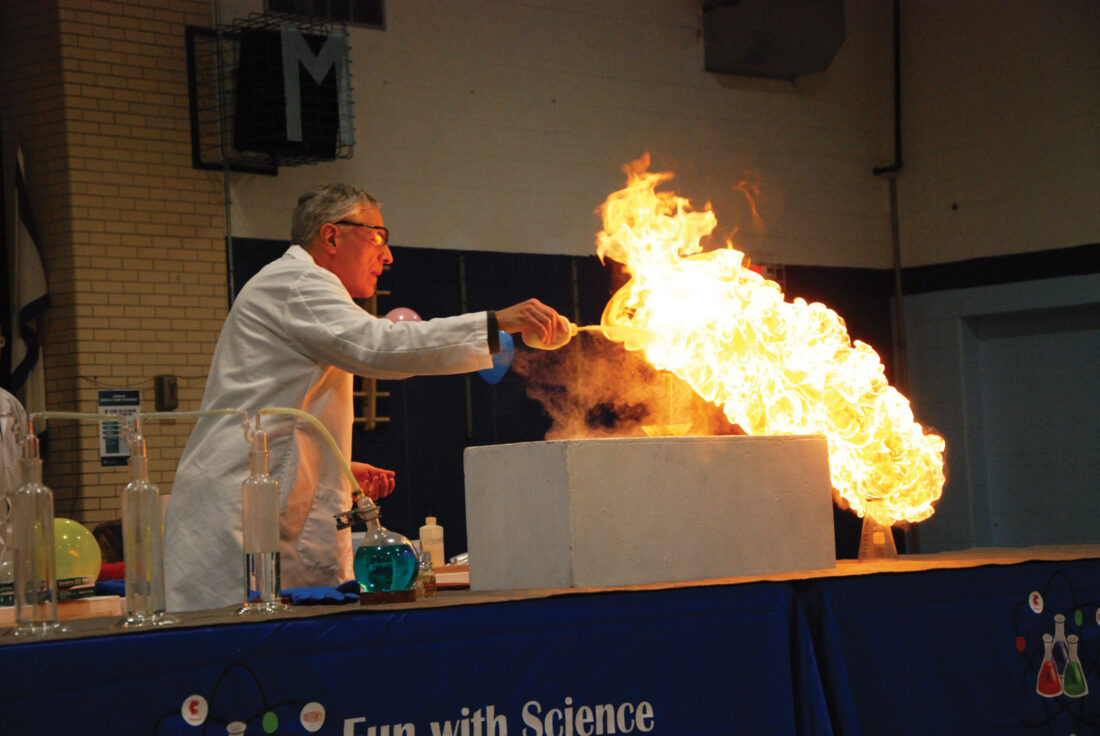
Chemours senior chemist Leo Lech used lycopodium powder to create a combustion reaction during a Washington Works Fun with Science presentation Friday at Madison Elementary School in Parkersburg. (Photo by Evan Bevins)
PARKERSBURG — The demonstrations performed by the Washington Works Fun with Science team at Madison Elementary School included activities both explosive and cool.
Like, 300 degrees below zero cool.
Employees of Chemours and DuPont Delrin at the Washington Works facility in Washington, W.Va., used liquid nitrogen, racquetballs, balloons and more to show students the surprising properties of everyday items and how changing factors like size and temperature can alter their properties in a program that kept students from kindergarten through fifth grade excited and attentive for an hour in the school’s gymnasium.
“It’s so much fun,” said Leo Lech, a senior chemist at Chemours who has been with the program since it started in the 1990s. “It’s trying to inspire the kids to get interested in science.
“It gives me an excuse to act like a kid on a Friday morning,” he added.
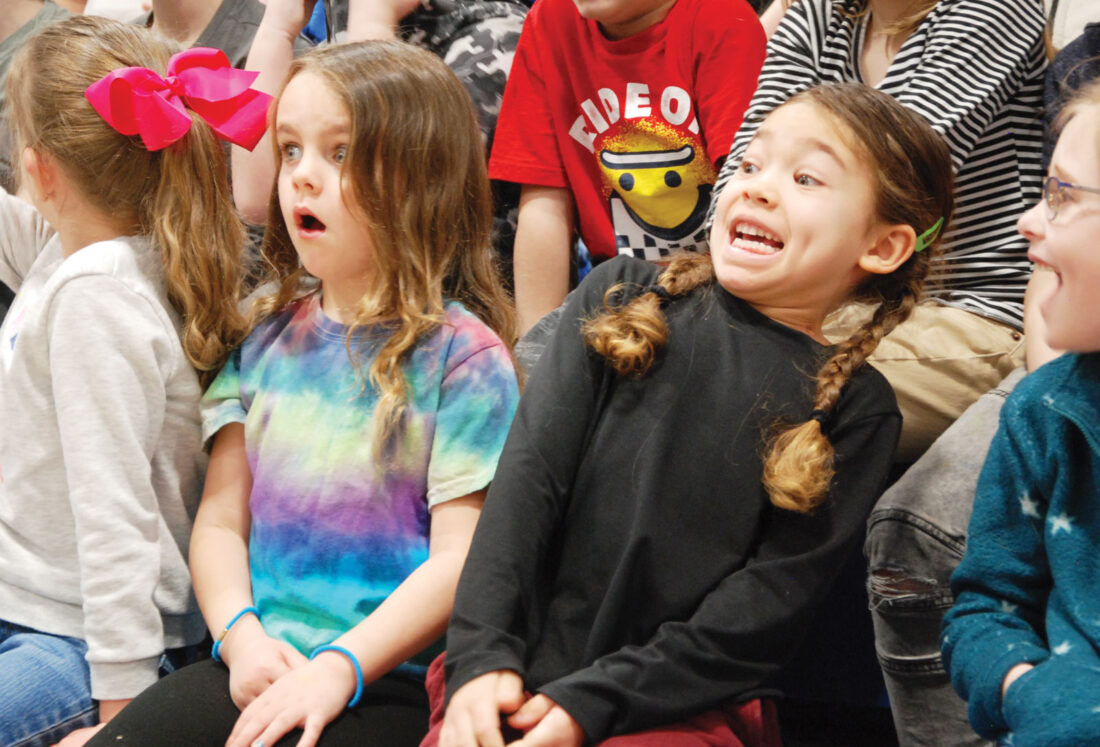
Madison Elementary School kindergarteners Zaelynn Daugherty, left, and Hazel Ellis reacted to flames generated in a combustion reaction during a Washington Works Fun with Science presentation Friday in their school’s gym. (Photo by Evan Bevins)
Chemours associate investigator Brad Bishop, another member of the team, estimated it must have been effective, since there are people working at the plant now who remember Lech coming to their schools in years past.
Kids at Madison Friday will likely remember the burst of flame as Lech sprayed lycopodium powder over a candle. The organic spores are similar to sawdust and were used by Lech to demonstrate how smaller particles make for better fuel in a combustion reaction because they provide more surface area to burn.
Students were surprised when DuPont Delrin quality manager Nikki Mackey sent a Pringles can rocketing toward the ceiling. The can had been filled with hydrogen, which Mackey lit as it escaped through a small hole. As air was pulled in through an opening on the bottom, oxygen was introduced into the container.
“When we got the right mixture of hydrogen and oxygen, it formed a combustible reaction,” Mackey said. “And this one went ‘boom.'”
Lech invited kindergartener Lilliana Jones to help him hammer a nail. There was just one problem.
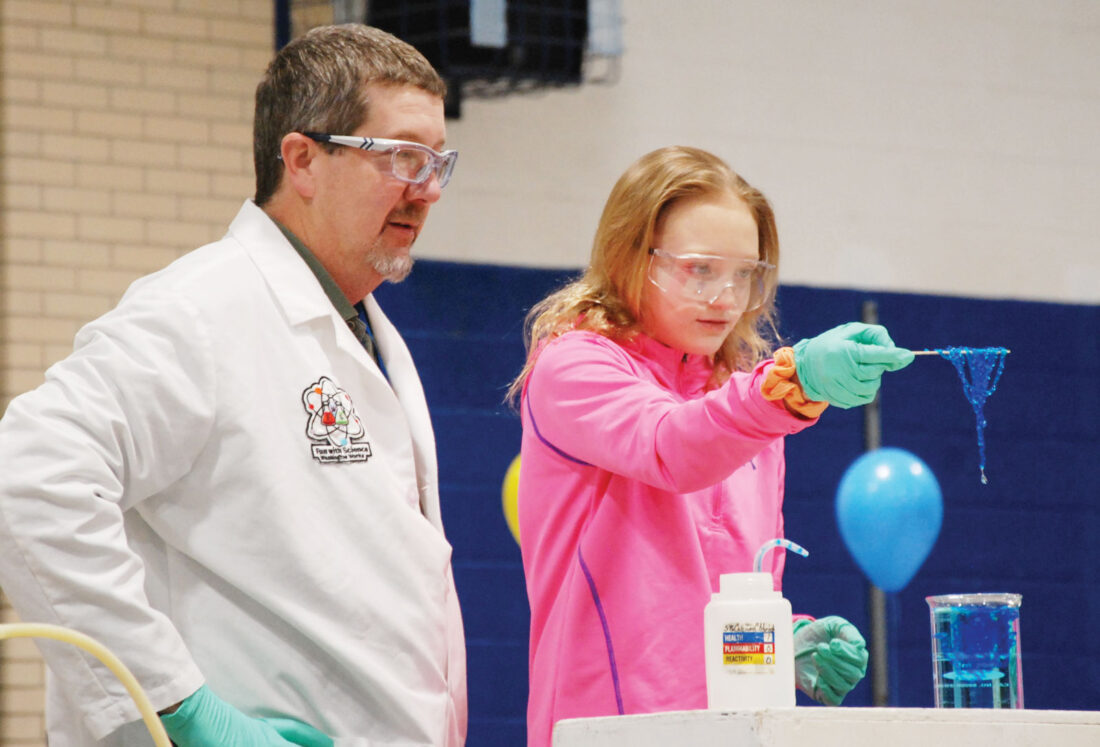
Madison Elementary School fourth-grader Lillyanne Winston, right, held up polymerized sodium algenate, a naturally occurring chemical found in seaweed, after pouring it in liquid form into a beaker containing a calcium chloride salt solution, under the direction of Brad Bishop, associate investigator at Chemours, during a Washington Works Fun with Science presentation Friday at the school. (Photo by Evan Bevins)
“We forgot our hammer. But that’s OK; we’ve got a banana,” he said.
Jones whacked the nail a few times with the first banana, resulting in a mushy hole and unattached nail.
“But we can do things to the banana to maybe make it a better hammer,” Lech said.
Then Bishop handed the student — wearing safety glasses and special gloves — a banana that had been submerged in liquid nitrogen, which Lech said gets down to 300 degrees below zero. Sure enough, the harder banana drove the nail into the wood for Jones.
Other demonstrations showed how a scrubbing system removes harmful byproducts produced in chemical reactions; how the polymer waterlock prevents leaks in diapers by solidifying liquids with which it comes in contact; and how dry ice placed in a bottle could fill a balloon as it warms, since it goes directly from a solid to gas form, a process called sublimation.
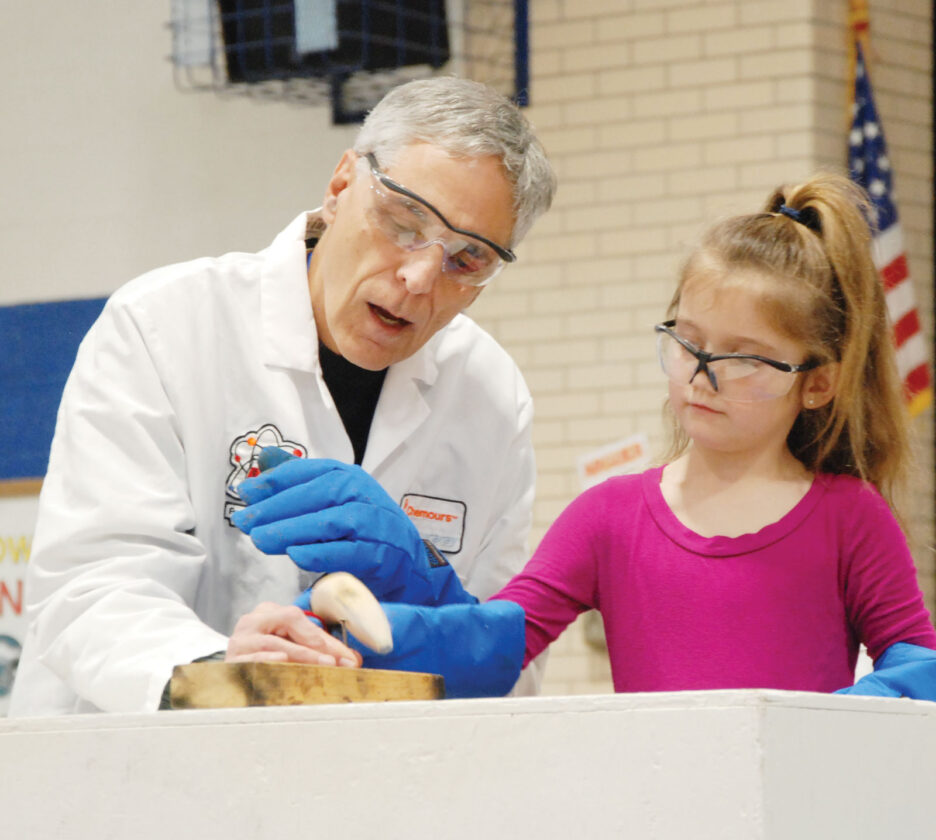
Madison Elementary School kindergartener Lilliana Jones hammered a nail using a banana frozen in liquid nitrogen, which made for a more effective tool than the unfrozen banana she tried for the first time at the instruction of Leo Lech, senior chemist at Chemours, during a Washington Works Fun with Science presentation Friday at the school. (Photo by Evan Bevins)
As the kids oohed, aahed, laughed or jumped in surprise, Lech and company encouraged them to observe the changes that took place, a key activity in science.
Fifth-grader Kameron Sims was impressed with the demonstrations and the demonstrators.
“I liked how they … were very professional with their work and how they were calm when the kids were talking when they weren’t supposed to,” he said, adding he “really appreciated” them coming to the school.
The program fits in with the school’s emphasis on S.T.E.M. — science, technology, engineering and mathematics — activities, Principal Valissa Porter said.
“It’s very nice for the kids to see local people that are doing interesting things in science,” she said.
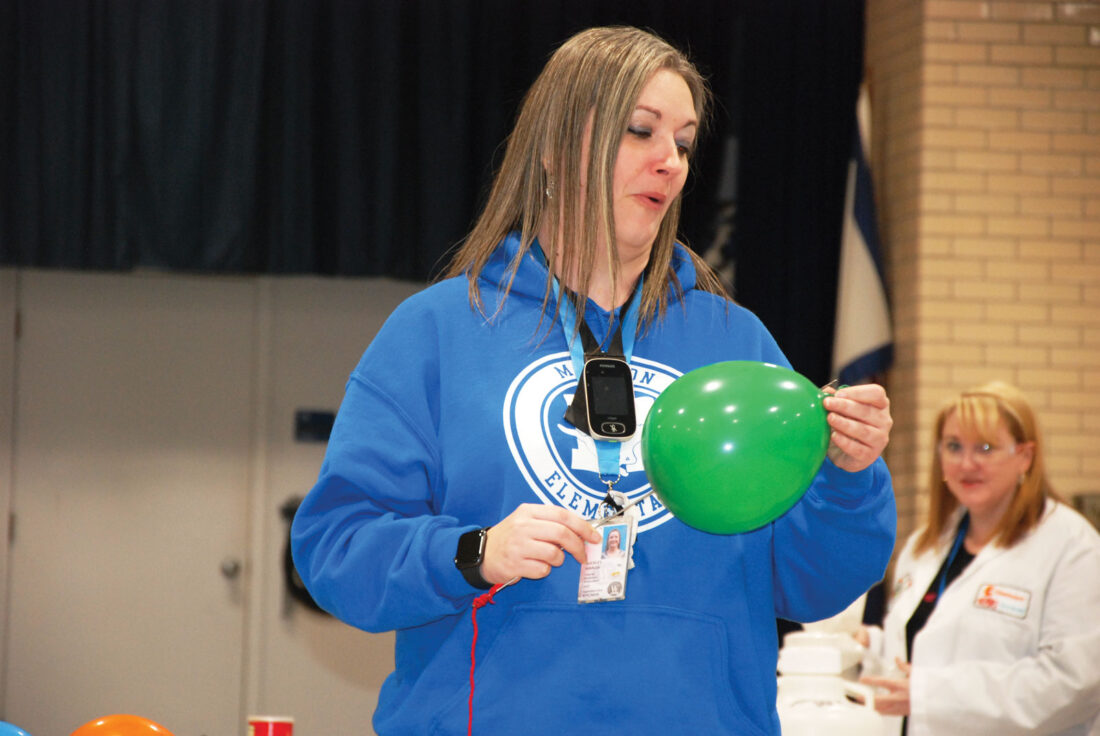
Madison Elementary School kindergarten teacher Marcia Buckley carefully pushed a needle through a balloon at the material’s darkest points, where Chemours representatives explained polymers were closer together, preventing the balloon from popping, during a Washington Works Fun with Science presentation Friday at the school. (Photo by Evan Bevins)
Evan Bevins can be reached at ebevins@newsandsentinel.com.

